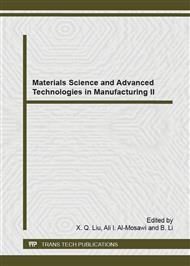[1]
ZHU Zhi-ping, ZHOU Yan, KONG Sheng-jie. Chemical Technology of Supercritical Thermal Power Generating Units [M]. Beijing: China Electric Power Press, 2012. (Chinese).
Google Scholar
[2]
HE Hui-chun. Emphsise on the harm of flow accelerated corrosion (FAC) [J].Su Zhou:the Sixth National Power Plant Chemistry Symposium Proceedings, 2000.(Chinese).
Google Scholar
[3]
lexander Y Superfin,Prabhat Kumar Sinha.Alternative Boiler feed-water treatment by using the oxygenated technique [J]. IWC, 1993, 53.
Google Scholar
[4]
Irma Dedekind,Denis Aspden,Ken J Gait,et a1.Oxygenatedfeed-water treatment at the world's largest fossil fired powerplant-beware ofthe pitfalls[J].Power Plant Chemistry,2001,3(11).
Google Scholar
[5]
HUANG Xiao-chun, XU Hong, ZHAO Yi-ming. The Feasibility Study on Implement of Feed-water Oxygenation Treatment in Ultra-supercritical Unit [J]. (Chinese).
Google Scholar
[6]
HE Lei,LIU Zhi-jie,NING Xian-wu. The Research of Feed-water Oxygenated Treatment for ultra-supercritical unit[J]. Northeast Electric Power Technology, 2012, 33(1). (Chinese).
Google Scholar
[7]
Alexander Y. Superfin, Prabhat Kumar Sinha: Alternative Boiler Feed-water Treatment by Using the Oxygenated Technique. IWC-93-53.
Google Scholar
[8]
Irma Dedekind, Denis Aspden, KenJ. Galt, Dave DAlgetty: Oxygenated Feed-water Treatment at the World's Largest Fossil Fired Power Plant –Beware of the Pitfalls. Power Plant Chemistry, 2001, 3(11).
Google Scholar
[9]
LI Jian-hua, ZHENG Min-cong, AN Sen, WANG Mei-bao. Analysis of Cycle Chemistry factors of Flow-accelerated Corrosion in Fossil Power Plant[J]. 2010 Power Plant Chemistry Academic Conference Papers, 2010. (Chinese).
Google Scholar
[10]
AI Zhi-hu, LIU Ding-ping. Key Issues of Oxygenated Feed-water Treatment for Supercritical Boiler [J]. Electric Power;2011, 44(3). (Chinese).
Google Scholar
[11]
FAN Wen-bia. Forming Reasons of Oxide Skin in Supercritical/Ultra-supercritical Preventive Measures [J]. Huadian Technology, 2011, 33(3). (Chinese).
Google Scholar
[12]
MCCLOSKEY T H, DOOLEY R B, MCNAUGHT0N W P. Turbine steam path damage: theory and practice [M].Electric Power Research Institute, Palo Alto, CA, (1999).
Google Scholar
[13]
YU Xue-bin, HE Gui-lin, WANG Hai-ou, GENG Zhao-long. Influence of Oxygen Treatment for Supercritical Units upon Formation and Pell-off of Oxide Skin. Thermal Power Generation. 2010, 39(7). (Chinese).
Google Scholar
[14]
I. G. Wright, R. B. Dooley. A review of the oxidation behaviour of structural alloysin steam[J]. International Materials Reviews, 2010, 55(3):129-167.
DOI: 10.1179/095066010x12646898728165
Google Scholar
[15]
XU Hong. Mechanism of OT-induced Exfoliation of Duplex Scale in Steam Path. Journal of Chinese Society of Power Engineering. 2011, 31(9). (Chinese).
Google Scholar
[16]
Wu Wen-long, HE Jun-feng, LI Chang-ming. Growth and exfoliation of Mechanism of Oxide Scale on Alloys Exposed to Steam of Supercritical (Ultra-supercritical) Units [J]. Proceedings of the 2011 conference of chemical plant, 2011. (Chinese).
Google Scholar
[17]
LI Chang-ming, Wu Wen-long, HE Jun-feng. The Research and Application of Weak Oxidizing Treatment for Feed-water [J]. Power plant chemical 2009 academic annual meeting and China power plant chemical web 2009 summit conference. (Chinese).
Google Scholar
[18]
ZHU Li-wei, QIAN Hai-zhou, ZHOU Chen, XIAO Xiu-lin. A New Oriented Oxidation Water Treatment Technology for Supercritical Units. Technical Exchange Conference 2010 for 600/1000MW Ultra-supercritical Units. (Chinese).
Google Scholar
[19]
FENG Li-kui, QLAN Zhou-hai,ZHOU Chen. Experimental Research on Low-Oxygen Feed-water Treatment for Once-through Boilers[J]. Electric Power, 2013, 46(4).
Google Scholar


